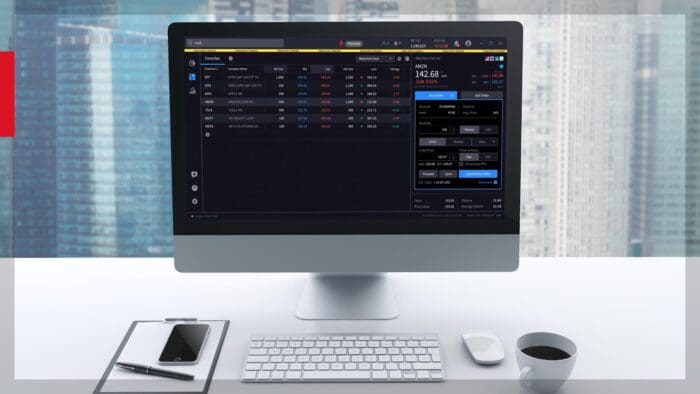While the stock market damage caused by Liberation Day and its aftermath is reparable, it may take some time to fully recover. How can investors position for more volatility?
The average stock is down 26% from its 52-week high, approaching a -2 standard deviation move, according to Strategas Research Partners.1 That puts this stock market decline — a reaction to President Trump’s Liberation Day reciprocal tariffs and China’s retaliation — on par with the 1987 market crash, Long Term Capital Management failure, Dotcom bubble bursting, Global Financial Crisis, and Covid pandemic.
Fifty years of market history combined with extreme negative sentiment, indiscriminate selling, and investor capitulation suggests that markets may be getting close to a bottom. But investors should consider two things before diving back into risk assets with both feet.
First, no US administration has ever tried to reset the world’s trading system. Second, historically, lows are retested and/or undercut 85% of the time, usually between four weeks to four months later.2
So while the stock market damage caused by Liberation Day and its aftermath is reparable, it may take some time to fully recover. To use President Trump’s metaphor, the patient has survived the surgery, but recovery could be a long, slow, and painful process.
A Solution in Search of a Problem
Donald Trump has been talking about America getting ripped off by its trading partners for 40 years. First it was Japan. Then it was China. And now, its everybody! Finally rid of free trade, globalists like Steven Mnuchin and Gary Cohn, President Trump can pursue his radical trade agenda without limits. When all you have is a hammer, everything looks like a nail.
Market participants, consumers, businesses, and US trading partners are frustrated with the Trump administration’s reciprocal tariffs. Investors are selling first and asking questions later. The endgame is unclear, and the goalposts are constantly moving. Is the goal of reciprocal tariffs to improve the trade deficit? Raise US government revenues? Strengthen national security? Restore manufacturing jobs? Eliminate fentanyl from entering the country? End illegal immigration? Is it all those things?
Let’s further examine the three most identified economic goals of Trump’s trade policy.
1. Improve the Trade Deficit
The US has been running a trade deficit for more than 50 years, since the 1970s. Nominal US GDP in 1970 was $1.1 trillion. Today, nominal US GDP is $29.7 trillion. US GDP per capita in 1970 was $5,266 compared to $86,601 in 2024.3 Despite a growing trade deficit, the US economy has grown substantially and living standards have increased.
Over the past 249 years, the US has transformed from an agricultural economy to an industrial economy to an innovative technology-driven services economy. The US’ strength is its adaptability. Economic progress cannot be stopped or reversed. The US will not retreat to an industrial economy. The US has its challenges — but trade deficits aren’t likely the cause of them.
Persistent trade deficits are an inescapable consequence of issuing the world’s reserve currency. The US dollar accounts for 60% of global foreign exchange reserves. Yet, the US economy only contributes about a quarter of global GDP. The US dollar is bought or sold in nearly 90% of global foreign exchange transactions.4 The US had $3.2 trillion in exports last year, but its largest export is US dollars that the rest of the world use as central bank reserves, to invest in the US stock market, and for trade settlements.5
It’s a mathematical certainty that the world’s reserve currency must run a deficit.
2. Raise US Government Revenues
President Trump has often praised President William McKinley, who was first elected in 1896, for his support of high tariffs. Trump boasted in his Liberation Day comments that, “From 1789 to 1913 we were a tariff-backed nation, and the United States was proportionately the wealthiest it has ever been.”
Peter Navarro, Counselor to the President of the United States and architect of Trump’s trade policy, recently claimed that tariffs would raise $600 billion a year, about $6 trillion in government revenues over the next 10 years. That would imply about a 15% tariff rate on $4.1 trillion in US imports for the next decade. That is a substantial increase in the US average effective tariff rate.
—
Originally Posted April 8, 2025 – Trump’s Trade War: What’s the Endgame?
Footnotes
1 “The Average Stock Is Already In A Bear Market,” Strategas Research Partners, April 7, 2025.
2 “3 Key Conditions, Reviewing Historical Analogues: ’62, ’81, ’87, ’98, & Still Long The Short-End,” Strategas Research Partners, April 7, 2025.
3 Bloomberg Finance, L.P., as of April 7, 2025.
4 Bloomberg Finance, L.P., as of April 7, 2025.
5 John Mauldin, The Tariff Recession?, April 5, 2025.
6 Jared Bernstein and Dean Baker, “Tariffs Won’t Bring a Boom in American Manufacturing.” Wall Street Journal, March 26, 2025.
7 John Mauldin, The Tariff Recession?, April 5, 2025.
Disclosure
Important Risk Information
Important Risk Information The information provided does not constitute investment advice and it should not be relied on as such. It should not be considered a solicitation to buy or an offer to sell a security. It does not take into account any investor’s particular investment objectives, strategies, tax status or investment horizon. You should consult your tax and financial advisor.
The views expressed in this material are the views of Michael Arone through the period ended April 7, 2025, and are subject to change based on market and other conditions. This document contains certain statements that may be deemed forward looking statements. Please note that any such statements are not guarantees of any future performance and actual results or developments may differ materially from those projected.
Investing involves risk including the risk of loss of principal.
Equity securities may fluctuate in value and can decline significantly in response to the activities of individual companies and general market and economic conditions. Diversification does not ensure a profit or guarantee against loss.
Past performance is not a reliable indicator of future performance.
All material has been obtained from sources believed to be reliable. There is no representation or warranty as to the accuracy of the information and State Street shall have no liability for decisions based on such information. The whole or any part of this work may not be reproduced, copied or transmitted or any of its contents disclosed to third parties without State Street Global Advisors’ express written consent.
AdTrax Code: 7833705.1.1.GBL.RTL
Expiry Date: 4/30/2026
© 2025 State Street Corporation – All Rights Reserved.
Disclosure: State Street Global Advisors
Do not reproduce or reprint without the written permission of SSGA.
All information has been obtained from sources believed to be reliable, but its accuracy is not guaranteed. There is no representation or warranty as to the current accuracy, reliability or completeness of, nor liability for, decisions based on such information and it should not be relied on as such.
State Street Global Advisors and its affiliates (“SSGA”) have not taken into consideration the circumstances of any particular investor in producing this material and are not making an investment recommendation or acting in fiduciary capacity in connection with the provision of the information contained herein.
ETFs trade like stocks, are subject to investment risk, fluctuate in market value and may trade at prices above or below the ETF’s net asset value. Brokerage commissions and ETF expenses will reduce returns.
Bonds generally present less short-term risk and volatility than stocks, but contain interest rate risk (as interest rates raise, bond prices usually fall); issuer default risk; issuer credit risk; liquidity risk; and inflation risk. These effects are usually pronounced for longer-term securities. Any fixed income security sold or redeemed prior to maturity may be subject to a substantial gain or loss.
Investing involves risk including the risk of loss of principal.
The whole or any part of this work may not be reproduced, copied or transmitted or any of its contents disclosed to third parties without SSGA’s express written consent.
Investing in high yield fixed income securities, otherwise known as “junk bonds”, is considered speculative and involves greater risk of loss of principal and interest than investing in investment grade fixed income securities. These Lower-quality debt securities involve greater risk of default or price changes due to potential changes in the credit quality of the issuer.
COPYRIGHT AND OTHER RIGHTS
Other third party content is the intellectual property of the respective third party and all rights are reserved to them. All rights reserved. No organization or individual is permitted to reproduce, distribute or otherwise use the statistics and information in this report without the written agreement of the copyright owners.
Definition:
Arbitrage: the simultaneous buying and selling of securities, currency, or commodities in different markets or in derivative forms in order to take advantage of differing prices for the same asset.
Fund Objectives:
SPY: The investment seeks to provide investment results that, before expenses, correspond generally to the price and yield performance of the S&P 500® Index. The Trust seeks to achieve its investment objective by holding a portfolio of the common stocks that are included in the index (the “Portfolio”), with the weight of each stock in the Portfolio substantially corresponding to the weight of such stock in the index.
VOO: The investment seeks to track the performance of a benchmark index that measures the investment return of large-capitalization stocks. The fund employs an indexing investment approach designed to track the performance of the Standard & Poor’s 500 Index, a widely recognized benchmark of U.S. stock market performance that is dominated by the stocks of large U.S. companies. The advisor attempts to replicate the target index by investing all, or substantially all, of its assets in the stocks that make up the index, holding each stock in approximately the same proportion as its weighting in the index.
IVV: The investment seeks to track the investment results of the S&P 500 (the “underlying index”), which measures the performance of the large-capitalization sector of the U.S. equity market. The fund generally invests at least 90% of its assets in securities of the underlying index and in depositary receipts representing securities of the underlying index. It may invest the remainder of its assets in certain futures, options and swap contracts, cash and cash equivalents, as well as in securities not included in the underlying index, but which the advisor believes will help the fund track the underlying index.
The funds presented herein have different investment objectives, costs and expenses. Each fund is managed by a different investment firm, and the performance of each fund will necessarily depend on the ability of their respective managers to select portfolio investments. These differences, among others, may result in significant disparity in the funds’ portfolio assets and performance. For further information on the funds, please review their respective prospectuses.
Entity Disclosures:
The trademarks and service marks referenced herein are the property of their respective owners. Third party data providers make no warranties or representations of any kind relating to the accuracy, completeness or timeliness of the data and have no liability for damages of any kind relating to the use of such data.
SSGA Funds Management, Inc. serves as the investment advisor to the SPDR ETFs that are registered with the United States Securities and Exchange Commission under the Investment Company Act of 1940. SSGA Funds Management, Inc. is an affiliate of State Street Global Advisors Limited.
Intellectual Property Disclosures:
Standard & Poor’s®, S&P® and SPDR® are registered trademarks of Standard & Poor’s® Financial Services LLC (S&P); Dow Jones is a registered trademark of Dow Jones Trademark Holdings LLC (Dow Jones); and these trademarks have been licensed for use by S&P Dow Jones Indices LLC (SPDJI) and sublicensed for certain purposes by State Street Corporation. State Street Corporation’s financial products are not sponsored, endorsed, sold or promoted by SPDJI, Dow Jones, S&P, their respective affiliates and third party licensors and none of such parties make any representation regarding the advisability of investing in such product(s) nor do they have any liability in relation thereto, including for any errors, omissions, or interruptions of any index.
BLOOMBERG®, a trademark and service mark of Bloomberg Finance, L.P. and its affiliates, and BARCLAYS®, a trademark and service mark of Barclays Bank Plc., have each been licensed for use in connection with the listing and trading of the SPDR Bloomberg Barclays ETFs.
Distributor: State Street Global Advisors Funds Distributors, LLC, member FINRA, SIPC, an indirect wholly owned subsidiary of State Street Corporation. References to State Street may include State Street Corporation and its affiliates. Certain State Street affiliates provide services and receive fees from the SPDR ETFs.
ALPS Distributors, Inc., member FINRA, is distributor for SPDR® S&P 500®, SPDR® S&P MidCap 400® and SPDR® Dow Jones Industrial Average, all unit investment trusts. ALPS Distributors, Inc. is not affiliated with State Street Global Advisors Funds Distributors, LLC.
Before investing, consider the funds’ investment objectives, risks, charges, and expenses. For SPDR funds, you may obtain a prospectus or summary prospectus containing this and other information by calling 1‐866‐787‐2257 or visiting www.spdrs.com. Please read the prospectus carefully before investing.
Disclosure: Interactive Brokers Third Party
Information posted on IBKR Campus that is provided by third-parties does NOT constitute a recommendation that you should contract for the services of that third party. Third-party participants who contribute to IBKR Campus are independent of Interactive Brokers and Interactive Brokers does not make any representations or warranties concerning the services offered, their past or future performance, or the accuracy of the information provided by the third party. Past performance is no guarantee of future results.
This material is from State Street Global Advisors and is being posted with its permission. The views expressed in this material are solely those of the author and/or State Street Global Advisors and Interactive Brokers is not endorsing or recommending any investment or trading discussed in the material. This material is not and should not be construed as an offer to buy or sell any security. It should not be construed as research or investment advice or a recommendation to buy, sell or hold any security or commodity. This material does not and is not intended to take into account the particular financial conditions, investment objectives or requirements of individual customers. Before acting on this material, you should consider whether it is suitable for your particular circumstances and, as necessary, seek professional advice.


















Join The Conversation
For specific platform feedback and suggestions, please submit it directly to our team using these instructions.
If you have an account-specific question or concern, please reach out to Client Services.
We encourage you to look through our FAQs before posting. Your question may already be covered!